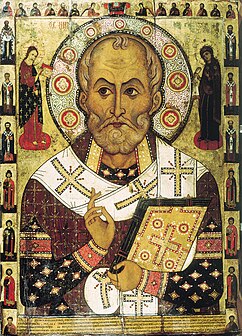St. Nicholas from Randy Sturgill on Vimeo.
San Nicola, Basilica di San Nicola, Bari, Italy
The Bari image combines Eastern and Western images.
Photo: Centro Studi Nicoliaiani
How did the Bishop of Myra become 'Saint in Bari'? It's a long way from Lycia to the eastern coast of Italy.
St. Nicholas' tomb in Myra was a popular place of pilgrimage. As Myra was a seaport, sailors heard the stories of the saint's shrine and carried them to many distant places. If a town were fortunate enough to host such a significant religious site, it enjoyed considerable commercial benefit because pilgrims needed to be housed, fed, and otherwise provided for. After Myra fell under the control of the Seljuks, who were not sympathetic to Christian faith, Italian merchants in both Venice and Bari, saw an opportunity to bring such advantage to their cities. Their motives were opportunistic, but also spiritual, as there was real fear that pilgrimage could become difficult and dangerous or that the shrine might even be desecrated.
St. Nicholas Church, Myra
St. Nicholas Church, Myra (Demre, Turkey)
Photo: Anglican World/JMR
Early in 1087, three ships with sailors and merchants from Bari stopped in Myra on their way home from Antioch. When they visited Nicholas' tomb, the monks showed them where the manna was extracted. The sailors then asked where the saint's body lay. The monks, perhaps naively, showed them. But the monks became suspicious and questioned the visitors about their intentions, "Surely you do not intend to take the saint's remains to your own region? If so, we won't allow it." However, in the end the Barians prevailed and broke open the tomb with an iron bar. The sailors spirited the bones away to the ship, escaping just ahead of the townspeople coming in hot pursuit.
The men of Bari sailed away on the long voyage back to the southeast coast of Italy. Before getting there, they stopped at a nearby port to make a beautiful box (casket) to hold the saint's relics. When they arrived in Bari, May 9, 1087, the townspeople thronged to the harbor to welcome the saint's remains. The returning men made a solemn vow to build a magnificent church to honor St. Nicholas.
The crypt was completed by October 1089 and Pope Urban II laid the relics of St. Nicholas beneath the crypt's altar, consecrating a shrine that became one of medieval Europe's great pilgrimage centers. The main church was built in ten years, but it wasn't until the middle of the 12th century that the imposing and majestic Basilica di San Nicola was complete. It is a particularly fine example of Romanesque architecture and served as a prototype for many other churches and cathedrals.
Please pray for the Orthodox convent of St Elizabeth in Minsk. They have a special devotion to this saint.
Please pray for the Orthodox convent of St Elizabeth in Minsk. They have a special devotion to this saint.
(As from 7.30pm last night, I am now in Peru and blogging from my monastery in Pachacamac.- Fr David)



No comments:
Post a Comment